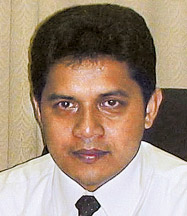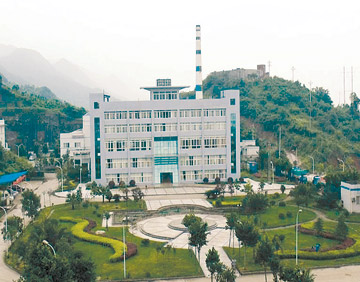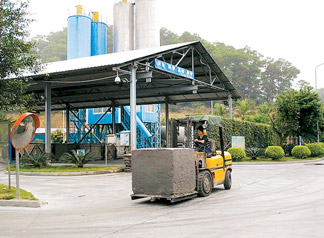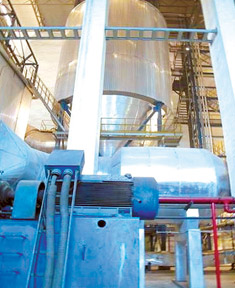Solid waste to be turned into renewable energy
By Ranil Wijayapala
 |
|
Nalin Mannapperuma |
When Sri Lanka was undergoing a development drive during the past few
decades it did not have time to pay attention about the negative
consequences of it. Many were of the opinion that the issue of garbage
will not be a problem for them as long as the country was having enough
lands to dump them. But it took quite some time to realise that it was
not so.
People started realising the gravity of this problem only when they
saw those small dumping grounds systematically rising to mountains of
garbage, even threatening surrounding human habitats and natural
environment, thus becoming a health hazard. Though they thought that the
small bags filled with garbage they threw in to those dumping grounds
without any concern about the environment will not be a problem, it
systematically grew as a problem to challenge them at their doorstep.
The truth behind the realisation of this fact actually is the bad
odour and health hazard that people were facing. Otherwise that will
also be one of the problems silently growing in the society like a time
bomb to be exploded. Though it was a subject that has to be tackled by
the Local Government bodies of the country, the requirement to have a
national level approach was highlighted to face this challenge.
When Environment Ministry started tackling the waste management issue
through its Pilisaru program introducing the 3R concept Reduce, Reuse
and Recycling, the Western Province the smallest province with the
largest population in the country responsible for 60 percent of the
total waste generation in the country also started facing this challenge
with the establishment of the Waste Management Authority under the
Western Provincial Council.
The available statistics show that the current generation of
municipal solid waste in the western province is around 3,200 to 3,500
metric tonnes per day and the per capita generation varies from one kilo
to 0.4 kg per day. But the collection is around 2,400 metric tonnes and
that is around 65 to 70 percent.
According to Deputy Director of Waste Management Authority Nalin
Mannapperuma this waste generation rate increase by 1.2 to 2 percent per
day and it is predicted that in 2050 the waste generation in the western
province will increase upto 5,800 metric tonnes per day.
"This is the biggest challenge we have to face in the years to come
and we are in the process of facing this challenge effectively by
introducing short-term, medium-term and long-term programs for waste
management in the Western province", he said.
Adopting Zonal concept in waste management, the WMA introduced
appropriate institution and administrative systems for waste management
and also to promote collaborative or sole approach for managing
municipal solid waste by sharing limited resources in waste management.
As another effective measure for waste management, the WMA also
introduced seven steps in managing waste to promote a unique regulatory
framework for Municipal Solid Waste management by sharing of
responsibilities among the individuals and the responsible organisations
from the waste generation to the final disposal. This is already in
within the legal framework of the waste management process in the
Western Province.
 |
|
The building for the
facility |
But the fact that the generation of 60 percent of the waste in a
province which shares only 6 percent of the land mass in the country,
make things worse for the Western Province.
So it has to think of better mechanism not only to collect those
waste and dump but also about mechanisms to get rid of the huge amount
of municipal waste collected by local authorities.
So the WMA has set targets for the managing of municipal waste
effectively without making it a problem for the people and also for the
development process.
"In 2016 the expected waste generation in the Western province is
3,200 metric tonnes per day. But the present collection is around 75
percent and we have plan to increase the waste collection by 95 percent
by 2016", Mannapperuma said.
To facilitate this process, source segregation or the separation of
waste at its source is also important. "Presently the source segregation
is around 16 to 18 percent and to achieve that targets we have plans to
increase it upto 50 percent and after we increase the source segregation
we can have separate garbage like perishable garbage and other forms of
garbage", he added.
Through the separation of waste the WMA is planning to use perishable
garbage for composting. A minimum of 450 metric tonnes of perishable
garbage amount to 15 percent of waste are going to divert for compost
plants.
Likewise 280 metric tonnes that amounts to nine percent of the
Municipal Solid Waste we are planning to make use for recycling.
The WMA has given 21 composting facilities for Local Authorities and
they have a designed capacity of the 2,229 metric tonnes per day. But
the current operation capacity of these facilities are around 53
percent; therefore they are underutilised.
"To overcome this situation in the next few years we are going to
increase the operational capacities of these composting facilities and
also we are planning to establish new facilities as well to reach that
target," he added.
"But the important thing here is that by composting and recycling we
can manage the solid waste for some extent. Totally we can't compost or
recycle. The rest of the material has higher energy value. That energy
value we can use for power generation", he said. When the authorities
are contemplating over the issue of using municipal solid waste for
power generation those waste to energy programs has now become a part of
the mass scale projects proposed by the WMA as a solution to tackle the
generation of waste within the Western Province.
"Based on the statistics we have to use minimum 2,000 metric tonnes
of municipal solid waste per day for renewable energy generation. That
amount is around 66 percent of the total solid waste generation in the
province. If we can achieve all these targets we can reduce open
dumping", he added.
Presently the incineration is very low and it will be increased upto
66 percent in 2016. In the Colombo district, the total waste generation
is around 2,100 metric tonnes per day. Out of the total waste generation
1,600 metric tonnes of waste being collected by the local authorities.
That is around 75 to 80 percent of total waste generation in the
district. By 2050 the total waste generation in the district will be
2,500 metric tonnes per day and the waste to energy requirement 1,500
metric tonnes per day. "To achieve that we have master plan and we have
two sites one in Karadiyana and the Kaduwela site for waste to energy
project. Karadiyana site requires 1,000 metric tonnes per day and
Kaduwela site needs 500 metric tonnes per day. So we can match the waste
to energy requirement and the total solid waste generation in the
district through this project.
 |
|
The designed facility |
The Waste Management Authority of the Western Provincial Council,
under the guidance of its Chief Minister Prasanna Ranathunga and the
provincial Ministers have been able to take the first step in the
endeavour of starting waste to energy project by sealing and agreement
with a private sector partner to commence Sri Lanka's first waste to
energy project in Korathota, Kaduwela.
Going through the stipulated mechanism in the process of selecting a
suitable developer for this project it has selected RenewGen
Environmental Ventures India (Pvt) Ltd as their private sector
partner in establishing this waste to energy project.
"This is a public and private partnership to implement this project
and we have signed a concession agreement on November 18, 2012", he
said.
This concession agreement was signed to provide a five acre land for
the RenewGen Environmental Venture, India Pvt Limited and also for the
uninterrupted supply of the municipal solid waste to the project and
also to support them obtaining all applicable approvals.
"The land identified for this is in Korathota, Kaduwela and it is an
abandoned metal quarry. The technology they used for incineration is
called mass incineration and it is a proven technology. And it is being
used 248 facilities in Europe, 21 facilities in the UK", he said.
"Through this project we can achieve economic benefits as it
generates 8 MW of sustainable energy to the National Grid and the WMA
can have five percent of the profit as an equity share", he said. Apart
from that it also cuts down the excess waste handling cost. "On the
environmental aspect, it can handle 400 to 600 metric tonnes of MSW in
an environmental friendly manner and also can produce Eco Bricks from
ash, generated by daily operation of the facility. It also generate 100
direct and indirect job opportunities and help development of
infrastructure facilities", he said.
He said the project was identified to be implemented on a priority
basis at the Colombo District Development Committee which was chaired by
President Mahinda Rajapaksa as a solution for the requirement of the
local government bodies in handling municipal solid waste.
The Environmental Impact Assessment (EIA) has been completed and the
construction is scheduled to begin in January next year and it will take
a minimum of 18 months to complete. But at the end of the year 2014 we
are in a position to accommodate garbage for the facility.
The WMA as partner of the RenewGen Environmental Protection Kotte Pvt
Ltd will supply the required solid waste for the project. The 8 Mega
watts of power generated through this project will be added to the
national grid.
 |
|
The state-of-the-art technology to be
used
for the facility |
Petroleum Industries Minister Susil Premjayantha and Mayor of
Kaduwela Municipal Council G.H. Buddhadasa also extended their support
to make this project a reality.
Apart from that facility another waste to energy facility will also
be started in Karadiyana. For the Karadiyana waste to energy project a
developer has been identified. The EIA for the project has been
submitted but not approved. Once they get the EIA approval they will
also commence the project at the end of 2014.
"Karadiyana site requires 1,000 metric tonnes per day and Kaduwela
site need 500 metric tonnes per day. So we can match the waste to energy
requirement and the total solid waste generation in the Colombo
district", he added.
"We are planning to start providing waste to energy projects in the
Gampaha and Kalutara districts also to solve the solid waste issues in
the districts apart from mass scale composting facilities and sanitary
land-fill projects which are being operated at present", he said.
So the implementation of Sri Lanka's first waste to energy project in
Korathota, Kaduwela will lead the Solid Waste Management in the country
towards a new direction, he added.
|



